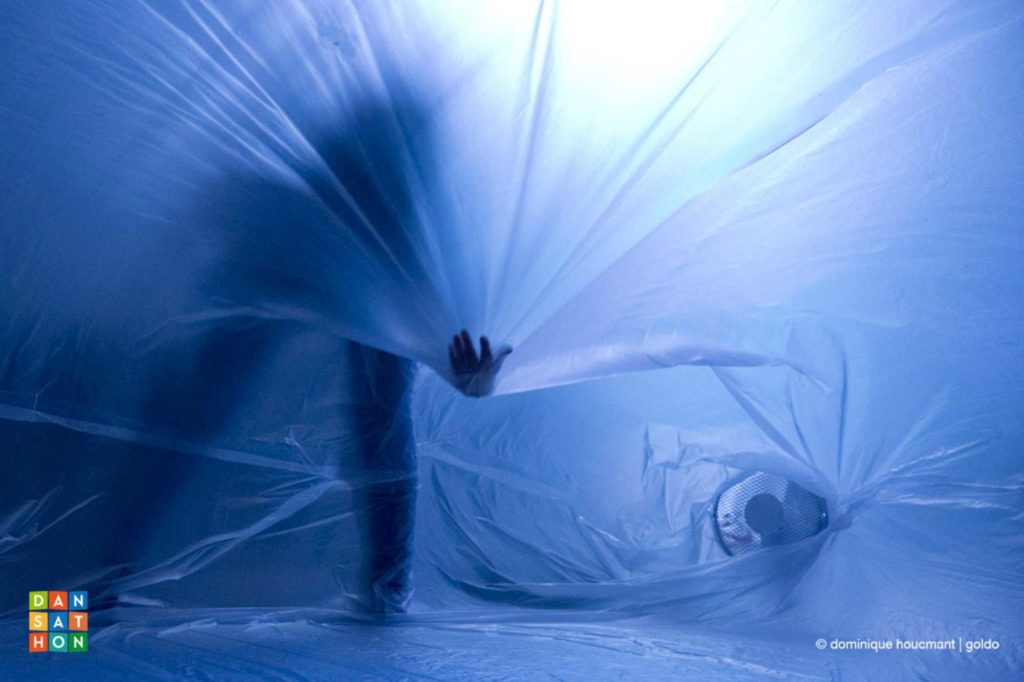ARTICLE DANCE OUT OF THE BOX
Three days, three cities and over 100 participants: the Danceathon — the first international dance hackathon — aimed to invent the dance of tomorrow. Here’s a look at one future aspect of choreography.
If you think all geeks feel gawky and self-conscious about their bodies and dancers are only interested in the organic and the flesh, think again. All it takes is spending some time at the Danceathon to shatter those stereotypes. You’ll have seen coders, many already close to the performing arts community, participating in choreographed warm-ups and artists with atypical profiles who have long thought about the relationship between technology and the body.
In London, choreographer and coder Amy Cartwright regrets that technology does not play a bigger role in dance schools, as it does in visual arts or music schools. In Lyon, choreographer Éric Minh Cuong Castaing’s pieces and films focus on how new technology has changed our view of the world. Although the two communities know more about each other than you might think, they have a hard time finding common ground in cultural institutions, despite the recent rise of initiatives allowing them to work together.
Shared intelligence
The BNP Paribas Foundation created the Danceathon in collaboration with the Maison de la danse in Lyon, the Théâtre de Liège and Sadler’s Wells in London. If the number of applications is anything to go by (400!), a marathon where members of both communities can dialogue and work more closely together came at just the right time.
For three days, people from different backgrounds focused on inventing a common language at the crossroads of their fields. They took the time to leave words aside, make connections with their bodies, put ideas in motion by taking a walk or find a form of translation allowing scientific concepts and ineffable feelings to communicate with each other. Jonathan Thonon, who programmes the Impact festival at the Théâtre de Liège, has no intention of stopping there.
“We must continue reactivating this community and keep it alive,”
Dance without borders
Cross-fertilisation between dance and technology has led to new forms of performance that theatres can no longer resist. Movement is imagined without borders or limits, omnipresent, mobile and part of daily life.
In London’s Double You project, a screen-wall serves to create dancing doubles of passersby. Ubiquity becomes possible with Cloud Dancing, the winning project in Liège, which uses virtual reality to diffract performance spaces in three different places. But technology can also be used to surpass the body’s limits. The Last Dance, an augmented reality experience created in Lyon, offers self-generating choreography with increasingly prolonged, evanescent gestures that could outlive humanity. Invented by another team in Lyon, the system of sensors in Dans(e) Sa Peau (Under Your Skin) allows viewers to feel in real time the energy flowing through the body of a performer at the height of his or her art.
Rethinking the viewer’s experience
Drawing inspiration from 2.0 web philosophy, the dance of tomorrow aims to be participatory, collaborative and above all true to its raison d’être: putting life at the centre and connecting people to each other. Like other projects, Crossflow in Lyon moves the choreographic experience outside the performance venue, in this case to a railway station. The prototype aims not just to shake travellers out of their daily routines through dance, but also to foster interaction between them under “sound showers” where playful “choreographic battles” take place.
“An app of danced encounters”
Vibes, the winning project in Lyon, is an app of danced encounters. Users can activate ballets together by following the beat of audio-guided choreography they listen to through earphones. They can also chat and exchange ideas about their instructions. In a retroactive loop, they influence the music depending on their number, orientation and speed. The viewer becomes not just a dancer but also a co-creator.
The Danceathon aims to be a thrilling encounter between dance and technology, but dissident voices are also emerging. In Liège, where a New Age trend of reconnecting with nature through technology seems to be catching on, a communicator and a coder have broken away from the herd to create a virtual reality project in their image. These two non-conformist heavy metal fans have designed a Gothic theatre where a parallel 3D programme could be imagined. By withdrawing from the competition, they broke out of the box to embrace its beauty. The pair offers a possible vision of the future of dance.
“We want to prolong theatre,” they say, “to offer people involved in digital technology who don’t necessarily go to the theatre the chance to see plays in VR in real time.”
While talk of the death of brick-and-mortar theatres may be a bit premature, digital technology is becoming a tool to reach a wider audience and broaden the performance experience. Some people are worried about virtual reality taking over our daily lives, but let’s trust these artists to keep dance on its toes.
Rédigé par Mouvement pour le Dansathon

